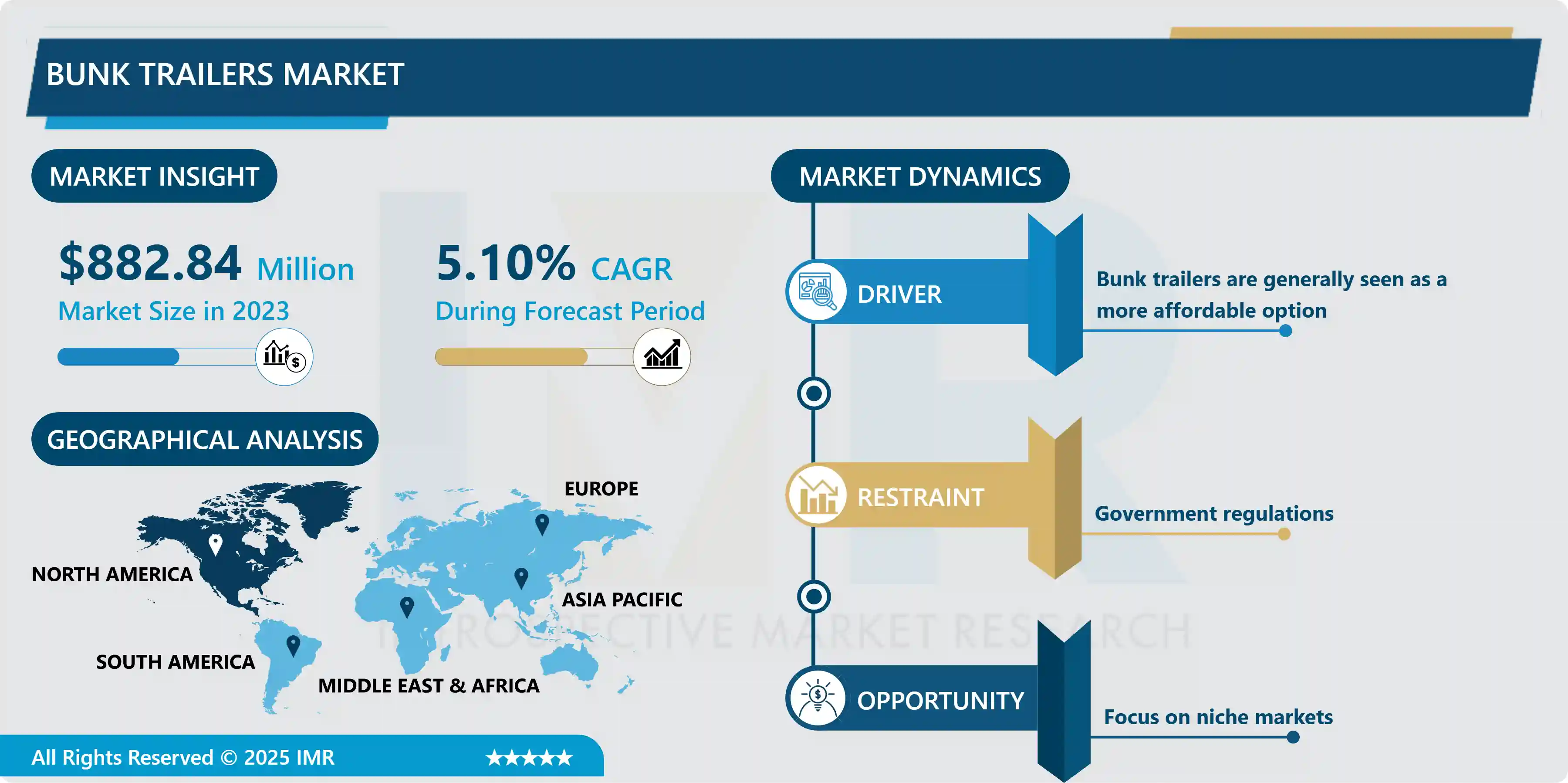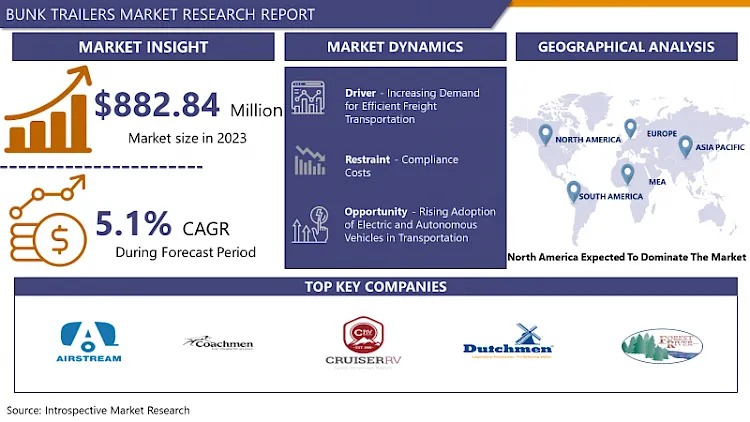Bunk Trailers Market Synopsis
Bunk Trailers Market Size was valued at USD 882.84 Million in 2023, and is Projected to Reach USD 1381.36 Million by 2032, Growing at a CAGR of 5.1% From 2024-2032.
Bunk trailers are specific trailer types designed to provide shipment services for boats. They have a set of bunks or cushions called `shaped rests that fit the form of a boat hull’ and can provide safe transportation.
These bunks are often protected with carpet or some other form of padding to not scratch the boat as it is moved about on the bunks. Boat owners widely use it because it is easier to tow a bunk trailer to launch or retrieve their boats to or from the water.
It is also important to maintain ease of use when it comes to the design of bunk trailers regarding the boat. The bunks usually vary in terms of the angles to fit various shapes and sizes of the boats and they also help in shifting the weight of the boat being towed across the trailer. This distribution helps to reduce the chances of the boat’s hull suffering damage as well as to provide a more comfortable and smoother trip. Also, bunk trailers are typically easier to load and deploy as the boat being towed can be maneuvered to get on the bunks easily. This is especially useful especially when it comes to single operators, or operators who may have little to no prior experience dealing with the towing or launching of boats.
As for construction, bunk trailers are designed to work on boating and fishing in both fresh water and sea water conditions. These are generally constructed employing galvanized steel or aluminium to avoid rusting and thus are durable. Some models also contain other application components like lighting or braking systems and an adjustable winch system to increase output and protection. Considering these characteristics, bunk trailers are convenient for many people who own boats as they provide a solid way to transport the boat, protect it from damaging and are easy to operate and very lasting.


Bunk Trailers Market Trend Analysis
The demand for low-maintenance
- One of the trends in the market that has been identified as being vital for the industry is the demand for low maintenance bunk trailers, and below are some of the reasons for this tendency. First of all, as you already noted, the modern consumer, especially those who indulge in outdoor and travel activities, is inclined to look for convenience and reliability in the products they buy. Bunk trailers that are of lowest maintenance fit this criterion so properly as bunk trailers usually need low maintenance focusing more on the adventures as possible. This trend is even more attractive to the younger generations, as the deficit of time that allows for proper treatment of acquired goods is of great concern to these people.
- There have been improvements in material and manufacturing technologies and thus improved on their ability to create more stronger bunk trailers. There are new materials with high reflection coefficient that can be used for manufacturing of the required products as weather conditions do not influence their quality and durability very much, and as a result, the frequency of repairs and other maintenance works decreases.
- Technological advancements including applying anti-corrosive coatings, enhanced sealing systems and producing the aluminium frame and structure denote that these trailers will be able to endure pressure and would not easily depreciate despite continuously being subjected to course conditions and usage. Hence, consumers are more likely to buy these models since they know that their low-maintenance benefits are likely to accrue to them for a long-term period.
- Low-maintenance bunk trailers, comes cheaper than the other high-end types of trailers making it easy for the buyers to afford. Despite the fact that it may cost some more on the first time one opts to build it, the returns are many times gained because of the little need for repairs as opposed to the other usual types of construction.
- Owners don’t have to worry about other related and constant costs like repair bills, new parts, and maintenance services that are involved for high trailers. This economic advantage combined with the benefits of owning a trouble-free and maintenance-free OmniFold makes these trailers a choice for the low-end buyer all the way to the up-scale buyer-seller.
Developing new bunk materials
- The second opportunity that has been seen in the bunk trailers market is the chance to develop new materiel able to provide better bunk, which will be more durable, comfortable and less expensive. Earlier types of bunk materials are sometimes associated with tear offs, low comfort and also high maintenance costs.
- By using other techniques such as enhanced materials like high density foams, or memory foams, or even using a mix of both but within a varying density range, manufacturers can come up with better products that addresses consumer needs. Moreover, these new materials result in better durability while at the same time enhancing the looks of the trailers, which is also essential for selling to individual users as well as fleets.
- Notably, investing in the use of environmentally sustainable and friendly materials create new markets that positively improve the company’s image. Given the rising awareness of people to the impacts of the environment, consumers and organizations are in search for sustainable solution.
- Recycling of materials used to construct bunks and the use of biodegradable materials can also have the added benefit of cutting down on production costs and would always serve the purpose of being environmentally friendly. This shift does not only support the companies to have a compliance with the regulations in the market, but also move the company to be a trend-setter or pioneer in sustainability which could be the key factor that attracts more customer and business opportunities to cooperate with other environmentally-conscious related businesses.
- In the last segment the utilization of new bunk material may also result to higher productivity yet lower cost in the production process. Rich experience and the application of progressive technologies and materials enable to simplify production processes, to minimize excess, and, consequently, reduce the cost. They are ‘within the product line’ which means that the savings can be subsequently implemented in the form of more competitive prices for their products or in the form of additional investments into the company’s research and development activities.
- Also, the increased quality of the bunk material can improve the capability and durability of the trailer decreasing the rate of failures and breakdowns as well as the need to repair or replace parts, which is an even more appealing idea for both – the manufacturer and the buyer. Such cycles of innovation and improvement can enable firms in the bunk trailers industry to remain relevant and hence foster its’ growth with the profit gains that accompany extended and efficient market competition.
Bunk Trailers Market Segment Analysis:
Bunk Trailers Market is segmented on the basis of Material and Type.
By Materials, Aluminium segment is expected to dominate the market during the forecast period
- The bunk trailers market is nearly entirely made from aluminum, which is the material of choice for constructing these trailers. The primary reasons can be understood well by understanding unique features that make aluminum particularly suitable for this market and for its manufacturers and consumers alike.
- First of all let’s mention that aluminum is lighter than steel, so it provides better fuel economy and means easier towing. Being a lightweight structure, this decreases the overall weight of the trailer, and as such is suitable for almost any towing vehicle, light trucks and sport utility vehicles included. Therefore, “aluminum bunk trailers,” are more affordable and will be available to a wider group of consumers, which increases the marketability of the product.
- A final noteworthy benefit of utilizing aluminium is because it does not corrode easily. Unlike steel though it is known to tend to rust?aluminum naturally has a skin that forms an oxide that cannot be eroded. This corrosion resistance is evidently valuable in trailers since they are periodically subjected to volatile weather and road saline. Despite the initial high cost, aluminum trailers’ ability to endure more use and the fact that they do not require frequent repairing and maintaining make them more economical in the long run. Consumers nowadays are fully aware of these prospects, thus explaining why aluminum becomes more popular compared to other materials.
- There are potential advantages such as better insulating and reinforcing properties when using composite material applications but currently composite materials are still bulky in the bunk trailer segment and the costs involved and technical difficulties associated with manoeuvring these are a stumbling block in most cases. Iron while being a fairly durable and robust material is heavy and finally corrodes; therefore, its use in this type of construction may not receive much preference though it is conventional.
- Given the fact that aluminium is light in weight, can easily age and is not easily corroded, it is for these reasons that aluminium has dominated the bunk trailers market; satisfying the requirements of the manufacturer as well as the consumer who requires a long lasting material that is easy to use.
By Type, Dry Bunk Trailers segment expected to held the largest share
- The segmentation of the bunk trailers market is largely characterized by the domination of the dry bunk trailers segment. This implies that dry bunk trailers dominate this market due to the fact that these trailers are flexible, versatile and applicable particularly in logistics, construction, and recreational purposes. Dry bunk trailers are used to move general cargo products that which do not necessarily need additional conditions for transportation such as temperature-sensitive fruits or livestock. Due to this flexibility, many firms consider them as their first option in searching for secure and easily customizable means of transport.
- The need for using the dry bunk trailers is additionally enhanced by the rising use of technology and e-shopping requiring carriage of even the smallest of retail items. With the increase of the COVID-19 cases and restriction measures, the demand for the online shopping also increases, and thus, the delivery of products from warehouse to consumers. There is enough space for storage and as well it can be easily loaded and unloaded, hence, dry bunk trailers should suffice for this purpose. This capability to haul virtually anything: TVs, fridges, CDs, clothes, furniture, etc. , always makes them a critical link in the logistics chain.
- On the other hand, livestock bunk trailers tend to be used by specific clients and are mostly related with agriculture and rearing of livestock. Although required for moving animals, it has many constraints when compared with extensive uses of dry bunk trailers. The “Others” category, which is composed of specialized trailers and those designed for specialized industries or uses also accounts for a relatively smaller percentage of the overall market share due to their specificity and lower demand.
- Consequently, dry bunk trailers remain the most popular type of bunk trailers today thanks to their functionality and suitability for use in practically every branch of logistics and supply chain, not to mention electronic commerce that is rapidly growing nowadays.
Bunk Trailers Market Regional Insights:
North America is Expected to Dominate the Market Over the Forecast period
- North America has been realised as the largest market for bunk trailers due to well-established transportation and logistics business. There is adequate physical framework for the rough carrying that is require for the transport of materials, which are big in size across long distances in the region. The many highway connections that exist play a great part in the need for enhanced bunk trailers since the demand for effective cargo transportation systems is ever high now. Because manufacturing, retailing, and production of crops rely heavily on logistic transport which requires large and powerful trailers.
- Also, the rules and regulation of North America, and advancement in technology are the factors that prevailed here. There are specific rules that regulate the safety and performance of transport in the region, which put pressure on manufacturers to write and deliver quality durable bunk trailers. Improvements in technological systems including advanced telematics and automation on the structures of the trailers positively impact operation effectiveness and safety rendering these trailers as valuable to businessmen. Many of the large-scale trailer manufacturing companies operate in North America which adds to the market growth as they consistently work on developing and releasing new innovative products that conform to the modern trend within the market.
- In addition, factors such as economic power influence the dominance of the North American region, in the bunk trailers market. The economic growth in the region is evident in high industrialization and consumer spending, which translates into a large market in means of transport. More companies make up the market, ranging from small and medium enterprises to large corporations that depend on bunk trailers for transport, and hence, the market grows continuously. However, the provision of financing schemes and sound trade policies that enable businesses to access and invest in better trailers facilitates the continuity of North America dominating the bunk trailers market.
Active Key Players in the Bunk Trailers Market
- Airstream, Inc. (USA)
- Coachmen RV (USA)
- Cruiser RV (USA)
- Dutchmen Manufacturing, Inc. (USA)
- Forest River, Inc. (USA)
- Grand Design RV (USA)
- Gulf Stream Coach, Inc. (USA)
- Heartland RV (USA)
- Jayco, Inc. (USA)
- KZ RV (USA)
- Lance Camper Manufacturing Corporation (USA)
- Newmar Corporation (USA)
- Northwood Manufacturing, Inc. (USA)
- Oliver Travel Trailers (USA)
- Palomino RV (USA)
- REV Group, Inc. (USA)
- Starcraft RV, Inc. (USA)
- Thor Industries, Inc. (USA)
- Tiffin Motorhomes, Inc. (USA)
- Winnebago Industries, Inc. (USA)
- Other key Players
Key Industry Developments in the Bunk Trailers Market
- In November 2023, Utility Trailer Manufacturing Company unveiled its latest lightweight bunk trailer model, engineered to enhance fuel efficiency and load capacity. This cutting-edge trailer incorporates advanced materials and aerodynamic design features to minimize drag and maximize performance.
- In September 2023, Wabash National Corporation introduced its latest refrigerated bunk trailer system, featuring advanced temperature control and monitoring capabilities. This state-of-the-art trailer is specifically designed to meet the stringent demands of the cold chain logistics industry.
|
Global Bunk Trailers Market |
|||
|
Base Year: |
2023 |
Forecast Period: |
2024-2032 |
|
Historical Data: |
2017 to 2023 |
Market Size in 2023: |
USD 882.84 Mn. |
|
Forecast Period 2024-32 CAGR: |
5.1% |
Market Size in 2032: |
USD 1381.36 Mn. |
|
Segments Covered: |
By Material |
|
|
|
By Type |
|
||
|
By Region |
|
||
|
Key Market Drivers: |
|
||
|
Key Market Restraints: |
|
||
|
Key Opportunities: |
|
||
|
Companies Covered in the report: |
|
||
Chapter 1: Introduction
1.1 Scope and Coverage
Chapter 2:Executive Summary
Chapter 3: Market Landscape
3.1 Market Dynamics
3.1.1 Drivers
3.1.2 Restraints
3.1.3 Opportunities
3.1.4 Challenges
3.2 Market Trend Analysis
3.3 PESTLE Analysis
3.4 Porter's Five Forces Analysis
3.5 Industry Value Chain Analysis
3.6 Ecosystem
3.7 Regulatory Landscape
3.8 Price Trend Analysis
3.9 Patent Analysis
3.10 Technology Evolution
3.11 Investment Pockets
3.12 Import-Export Analysis
Chapter 4: Bunk Trailers Market by Material (2018-2032)
4.1 Bunk Trailers Market Snapshot and Growth Engine
4.2 Market Overview
4.3 Steel
4.3.1 Introduction and Market Overview
4.3.2 Historic and Forecasted Market Size in Value USD and Volume Units
4.3.3 Key Market Trends, Growth Factors, and Opportunities
4.3.4 Geographic Segmentation Analysis
4.4 Aluminium
4.5 Composite
Chapter 5: Bunk Trailers Market by Type (2018-2032)
5.1 Bunk Trailers Market Snapshot and Growth Engine
5.2 Market Overview
5.3 Dry Bunk Trailers
5.3.1 Introduction and Market Overview
5.3.2 Historic and Forecasted Market Size in Value USD and Volume Units
5.3.3 Key Market Trends, Growth Factors, and Opportunities
5.3.4 Geographic Segmentation Analysis
5.4 Livestock Bunk Trailers
5.5 Others
Chapter 6: Company Profiles and Competitive Analysis
6.1 Competitive Landscape
6.1.1 Competitive Benchmarking
6.1.2 Bunk Trailers Market Share by Manufacturer (2024)
6.1.3 Industry BCG Matrix
6.1.4 Heat Map Analysis
6.1.5 Mergers and Acquisitions
6.2 AIRSTREAM INC. (USA)
6.2.1 Company Overview
6.2.2 Key Executives
6.2.3 Company Snapshot
6.2.4 Role of the Company in the Market
6.2.5 Sustainability and Social Responsibility
6.2.6 Operating Business Segments
6.2.7 Product Portfolio
6.2.8 Business Performance
6.2.9 Key Strategic Moves and Recent Developments
6.2.10 SWOT Analysis
6.3 COACHMEN RV (USA)
6.4 CRUISER RV (USA)
6.5 DUTCHMEN MANUFACTURING INC. (USA)
6.6 FOREST RIVER INC. (USA)
6.7 GRAND DESIGN RV (USA)
6.8 GULF STREAM COACH INC. (USA)
6.9 HEARTLAND RV (USA)
6.10 JAYCO INC. (USA)
6.11 KZ RV (USA)
6.12 LANCE CAMPER MANUFACTURING CORPORATION (USA)
6.13 NEWMAR CORPORATION (USA)
6.14 NORTHWOOD MANUFACTURING INC. (USA)
6.15 OLIVER TRAVEL TRAILERS (USA)
6.16 PALOMINO RV (USA)
6.17 REV GROUP INC. (USA)
6.18 STARCRAFT RV INC. (USA)
6.19 THOR INDUSTRIES INC. (USA)
6.20 TIFFIN MOTORHOMES INC. (USA)
6.21 WINNEBAGO INDUSTRIES INC. (USA)
6.22 OTHER KEY PLAYERS
Chapter 7: Global Bunk Trailers Market By Region
7.1 Overview
7.2. North America Bunk Trailers Market
7.2.1 Key Market Trends, Growth Factors and Opportunities
7.2.2 Top Key Companies
7.2.3 Historic and Forecasted Market Size by Segments
7.2.4 Historic and Forecasted Market Size by Material
7.2.4.1 Steel
7.2.4.2 Aluminium
7.2.4.3 Composite
7.2.5 Historic and Forecasted Market Size by Type
7.2.5.1 Dry Bunk Trailers
7.2.5.2 Livestock Bunk Trailers
7.2.5.3 Others
7.2.6 Historic and Forecast Market Size by Country
7.2.6.1 US
7.2.6.2 Canada
7.2.6.3 Mexico
7.3. Eastern Europe Bunk Trailers Market
7.3.1 Key Market Trends, Growth Factors and Opportunities
7.3.2 Top Key Companies
7.3.3 Historic and Forecasted Market Size by Segments
7.3.4 Historic and Forecasted Market Size by Material
7.3.4.1 Steel
7.3.4.2 Aluminium
7.3.4.3 Composite
7.3.5 Historic and Forecasted Market Size by Type
7.3.5.1 Dry Bunk Trailers
7.3.5.2 Livestock Bunk Trailers
7.3.5.3 Others
7.3.6 Historic and Forecast Market Size by Country
7.3.6.1 Russia
7.3.6.2 Bulgaria
7.3.6.3 The Czech Republic
7.3.6.4 Hungary
7.3.6.5 Poland
7.3.6.6 Romania
7.3.6.7 Rest of Eastern Europe
7.4. Western Europe Bunk Trailers Market
7.4.1 Key Market Trends, Growth Factors and Opportunities
7.4.2 Top Key Companies
7.4.3 Historic and Forecasted Market Size by Segments
7.4.4 Historic and Forecasted Market Size by Material
7.4.4.1 Steel
7.4.4.2 Aluminium
7.4.4.3 Composite
7.4.5 Historic and Forecasted Market Size by Type
7.4.5.1 Dry Bunk Trailers
7.4.5.2 Livestock Bunk Trailers
7.4.5.3 Others
7.4.6 Historic and Forecast Market Size by Country
7.4.6.1 Germany
7.4.6.2 UK
7.4.6.3 France
7.4.6.4 The Netherlands
7.4.6.5 Italy
7.4.6.6 Spain
7.4.6.7 Rest of Western Europe
7.5. Asia Pacific Bunk Trailers Market
7.5.1 Key Market Trends, Growth Factors and Opportunities
7.5.2 Top Key Companies
7.5.3 Historic and Forecasted Market Size by Segments
7.5.4 Historic and Forecasted Market Size by Material
7.5.4.1 Steel
7.5.4.2 Aluminium
7.5.4.3 Composite
7.5.5 Historic and Forecasted Market Size by Type
7.5.5.1 Dry Bunk Trailers
7.5.5.2 Livestock Bunk Trailers
7.5.5.3 Others
7.5.6 Historic and Forecast Market Size by Country
7.5.6.1 China
7.5.6.2 India
7.5.6.3 Japan
7.5.6.4 South Korea
7.5.6.5 Malaysia
7.5.6.6 Thailand
7.5.6.7 Vietnam
7.5.6.8 The Philippines
7.5.6.9 Australia
7.5.6.10 New Zealand
7.5.6.11 Rest of APAC
7.6. Middle East & Africa Bunk Trailers Market
7.6.1 Key Market Trends, Growth Factors and Opportunities
7.6.2 Top Key Companies
7.6.3 Historic and Forecasted Market Size by Segments
7.6.4 Historic and Forecasted Market Size by Material
7.6.4.1 Steel
7.6.4.2 Aluminium
7.6.4.3 Composite
7.6.5 Historic and Forecasted Market Size by Type
7.6.5.1 Dry Bunk Trailers
7.6.5.2 Livestock Bunk Trailers
7.6.5.3 Others
7.6.6 Historic and Forecast Market Size by Country
7.6.6.1 Turkiye
7.6.6.2 Bahrain
7.6.6.3 Kuwait
7.6.6.4 Saudi Arabia
7.6.6.5 Qatar
7.6.6.6 UAE
7.6.6.7 Israel
7.6.6.8 South Africa
7.7. South America Bunk Trailers Market
7.7.1 Key Market Trends, Growth Factors and Opportunities
7.7.2 Top Key Companies
7.7.3 Historic and Forecasted Market Size by Segments
7.7.4 Historic and Forecasted Market Size by Material
7.7.4.1 Steel
7.7.4.2 Aluminium
7.7.4.3 Composite
7.7.5 Historic and Forecasted Market Size by Type
7.7.5.1 Dry Bunk Trailers
7.7.5.2 Livestock Bunk Trailers
7.7.5.3 Others
7.7.6 Historic and Forecast Market Size by Country
7.7.6.1 Brazil
7.7.6.2 Argentina
7.7.6.3 Rest of SA
Chapter 8 Analyst Viewpoint and Conclusion
8.1 Recommendations and Concluding Analysis
8.2 Potential Market Strategies
Chapter 9 Research Methodology
9.1 Research Process
9.2 Primary Research
9.3 Secondary Research
|
Global Bunk Trailers Market |
|||
|
Base Year: |
2023 |
Forecast Period: |
2024-2032 |
|
Historical Data: |
2017 to 2023 |
Market Size in 2023: |
USD 882.84 Mn. |
|
Forecast Period 2024-32 CAGR: |
5.1% |
Market Size in 2032: |
USD 1381.36 Mn. |
|
Segments Covered: |
By Material |
|
|
|
By Type |
|
||
|
By Region |
|
||
|
Key Market Drivers: |
|
||
|
Key Market Restraints: |
|
||
|
Key Opportunities: |
|
||
|
Companies Covered in the report: |
|
||













